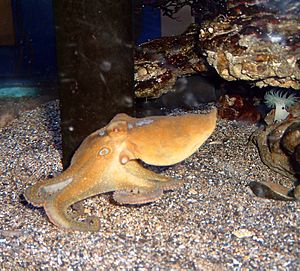California two-spot octopus facts for kids
Quick facts for kids California two-spot octopus |
|
|---|---|
 |
|
| At Heal the Bay Aquarium | |
| Conservation status | |
| Scientific classification | |
| Genus: |
Octopus
|
| Species: |
bimaculoides
|
The California two-spot octopus (Octopus bimaculoides) is a cool sea creature. People often call it a "bimac." This octopus lives in many parts of the Pacific Ocean. You can find it along the coast of California.
It's easy to spot this octopus! Look for the round blue spots on each side of its head. These spots look like eyes. Most bimacs live for about two years. They are related to another octopus called Verrill's two-spot octopus (Octopus bimaculatus). Scientists even mapped its genome in 2015.
Contents
About the California Two-Spot Octopus
The California two-spot octopus can grow quite large. Its body, called the mantle, can be about 17.5 centimeters (7 inches) long. Its arms can stretch up to 58 centimeters (23 inches)!
This octopus isn't usually bumpy. It comes in different colors, like gray with yellow spots. It's a master of crypsis, which means it's super good at changing its color. This helps it blend in with its surroundings. It's like a natural camouflage artist!
Octopuses change color using special cells in their skin. These cells are called chromatophores, iridophores, and leucophores. Chromatophores are like tiny bags of color. They can expand and shrink to show or hide pigment. Leucophores are important because they reflect white light. This helps the octopus match the light in its home. Its amazing brain controls all these color changes. This helps the octopus create patterns to hide.
This octopus gets its name from the fake eye spots under its real eyes. These spots are a shiny blue color. They have a chain-link pattern inside a black circle.
On its arms, the octopus has many "suckers." It uses these suckers to taste things! This octopus also has three hearts and two gills. Its blood is blue, and its brain is shaped like a donut.
Where They Live
You can find O. bimaculoides in coastal waters. They live in the eastern Pacific Ocean. This includes areas along mid- and southern-California. They also live on the western side of the Baja California Peninsula in Mexico.
These octopuses live in water that is not too deep. You can find them from the intertidal zone (where the ocean meets the land) down to about 20 meters (65 feet) deep. They like to hide in rocky reefs or among debris. They can live in water temperatures from 15 to 26 degrees Celsius (60-80 degrees Fahrenheit). But they like it best when the water is between 18 and 22 degrees Celsius (65-72 degrees Fahrenheit).
Life and Habits
Lifespan
These octopuses usually live for about one to one and a half years in the wild. If they live in an aquarium, they can sometimes live up to two years. Their life cycle ends when the female lays eggs. Both males and females then get old and die.
Diet
California two-spot octopuses don't live very long. So, they grow up fast! They can hunt for food right after they hatch. Baby octopuses eat small creatures like amphipods or mysid shrimp. As they get bigger, they eat more kinds of food. They will eat almost anything they can find. This includes fish and crabs. They hunt at night because they are nocturnal. Their amazing camouflage helps them catch their prey.
Reproduction
Towards the end of their lives, these octopuses are ready to have babies. They are semelparous. This means they mate and reproduce only once in their lives. They can mate at any time of the year. But it's most common in the summer when the water is warmer.
The male uses special packets called spermatophores to fertilize the female. The male octopus usually dies soon after mating.
After mating, the female octopus finds a safe spot to make a den. She will lay between 20 and 100 eggs. She takes great care of her eggs. She blows cool water over them with her siphon. This gives the eggs oxygen. She does this until the eggs hatch. This can take a long time, from 150 to 210 days. During this time, the female octopus does not eat. She gets weaker and weaker, and usually dies after her eggs hatch.
Amazing Octopus Genetics
New science has helped us learn more about the California two-spot octopus. Scientists studied its genome. They found that this octopus has many special genes called protocadherins (PCDH). It has 168 of these genes!
These PCDH genes are grouped together in an organized way. They are lined up head-to-tail in the octopus's genome. This is different from how these genes are found in mammals. It shows how unique octopus genetics can be!
Octopus Studies
Scientists love to study octopuses! In one study, researchers tagged Octopus bimaculatus (a close relative). They used special tracking devices to watch where the octopuses moved. They found that these octopuses often move from one den to another every few days. Their movements during the day changed a lot. This helps them avoid predators.
Another study looked at the diet of octopuses. Scientists used a method called Stable Isotope Analysis (SIA). They wanted to see if octopuses living in protected areas ate differently. They compared octopuses from Marine Protected Areas (MPAs) to those from non-protected areas.
By looking at the chemicals in the octopuses' bodies, scientists could tell what they had been eating. They found that octopuses in the protected areas had a wider variety of food in their diet. This means that protected areas help octopuses have more food choices.
See also
- Terrance the octopus


